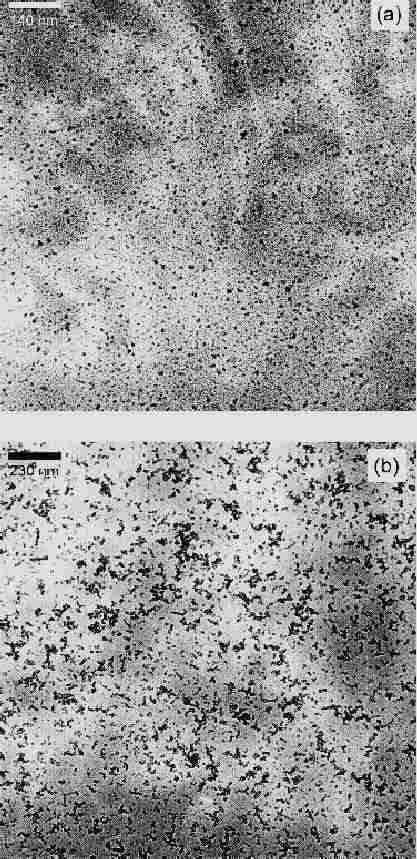 click
...
click
...1. The effect of particle clustering
Transmission electron microscopy (TEM)
To study the infuence of particle agglomeration onto the absorption characteristic of carbon nano-grains, the extraction distance between source and extraction nozzle (see experimental setup) was varied between 15 and 25 mm. Therefore, at larger distances, the primarily condensed nano-grains had more time to coagulate before they were extracted and matrix-isolated.
The TEM-images above give the particle distributions in the beam for a short (15 mm, (a)) as well as long (25 mm, (b)) extraction distance. For short distances the particle beam consists of single grains in a monodisperse size distribution with a mean size (diameter) of 8 nm. For larger distances the beam particles are strongly clustered in a wide cluster size distribution going from single grains to clusters which consist of up to 50 grains.
Matrix isolation spectroscopy
The UV/VIS spectra for the matrix isolated grain samples having different states of agglomeration show a systematic broadening of the pi-pi* absorption feature (at 237 nm) that is obviously correlated with the increase of clustering in the samples. Such a behaviour is expected from the Mie theory in the Rayleigh limit (particle size << wavelength) where the absorption is strongly influenced by the shape of the particles (surface resonances). The simple morphology of the nano-grains extracted at short distances enables the reliable derivation of a dielectric function for the particle material (see our page of optical constants). To simulate the measured spectroscopic change as a function of the clustering degree in the sample, the generalized Mie code developed by Rouleau (1996) for sphere agglomerates was used to calculate the extinction of small cluster-cluster agglomerates (CCA). The dielectric function evaluated from the spectrum of the single grains, was used as input for the simulations. The similarity of the measured UV spectra of the beam particles (upper panel) to the simulated spectra of the CCA aggregates (lower panel) is remarkable. This is a strong evidence for the existence of shape effects in the absorption characteristic of nano-sized carbon particles and should be taken into account when discussing the optical behaviour of carbon particles or soot.